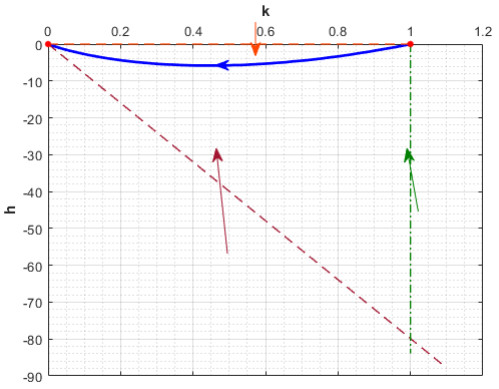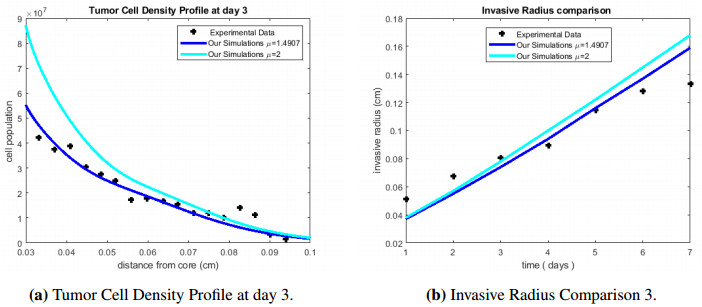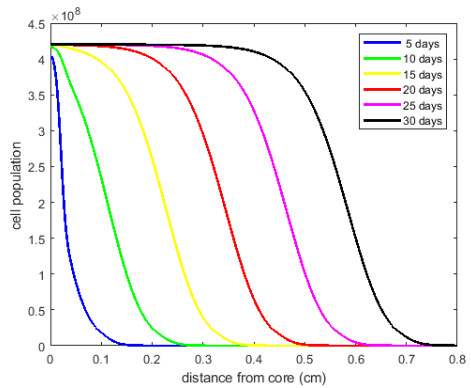|
[1]
|
Cancer, Fact Sheets, World Health Organization, 2018. Available from: https://www.who.int/en/news-room/fact-sheets/detail/cancer.
|
|
[2]
|
Brain Cancer, Fact Sheets, National Cancer Institute. Available from: https://www.cancer.gov/types/brain/patient/adult-brain-treatment-pdq.
|
|
[3]
|
International Agency for Research on Cancer, Report of World Health Organization, 2018. Available from: http://gco.iarc.fr/today/data/factsheets/populations/900-world-fact-sheets.pdf.
|
|
[4]
|
Brain Tumor: Statistics, eJournal Cancer, Net of American Society of Clinical Oncology, January 2020. Available from: https://www.cancer.net/cancer-types/brain-tumor/statistics.
|
|
[5]
|
Glioblastoma Multiforme: a giving smarter guide to accelerating research progress, Faster Cures Glioblastoma Report, Center of Milken Institute, 2014. Available from: https://www.fastercures.org/assets/Uploads.
|
|
[6]
|
T. Alarcón, H. M. Byrne, P. K. Maini, A multiple scale model for tumor growth, Multiscale Model. Simul., 3 (2005), 440-475. doi: 10.1137/040603760

|
|
[7]
|
K. R. Swanson, E. Alvord, J. Murray, A quantative model for differential motility of gliomas in grey and white matter, Cell Proliferation, 33, (2000), 317-330.
|
|
[8]
|
K. R. Swanson, C. Bridge, J. Murray, E. Alvord, Virtual and real brain tumors: using mathematical modeling to quantify glioma growth and invasion, J. Neurol. Sci., 216, (2003), 1-10.
|
|
[9]
|
S. E. Eikenberry, T. Sankar, M. Preul, E. Kostelich, C. Thalhauser and Y. Kuang, Virtual glioblastoma: Growth, migration and treatment in a three-dimensional mathematical model, Cell Proliferation, 42 (2009), 115-134.
|
|
[10]
|
G. Powathil, M. Kohandel, S. Sivaloganathan, A. Oza, M. Milosevic, Mathematical modeling of brain tumors: effects of radiotherapy and chemotherapy, Phys. Med. Biol., 52 (2007), 3291-3306. doi: 10.1088/0031-9155/52/11/023

|
|
[11]
|
H. Hatzikirou, A. Deutsch, C. Schaller, M. Simon, K. Swanson, Mathematical modelling of Glioblastoma tumour development: a review, Math. Models Methods Appl. Sci., 24 (2005), 1779-1794.
|
|
[12]
|
N. L. Martirosyan, E. M. Rutter, W. L. Ramey, E. J. Kostelich, Y. Kuang, M. C. Preul, Mathematically modeling the biological properties of Gliomas: a review, Math. Biosci. Eng., 12 (2015), 879-905. doi: 10.3934/mbe.2015.12.879

|
|
[13]
|
J. Murray, Glioblastoma brain tumours: Estimating the time from brain tumour initiation and resolution of a patient survival anomaly after similar treatment protocols, J. Biol. Dyn., 6 (2012), 118-127. doi: 10.1080/17513758.2012.678392

|
|
[14]
|
L. Curtin, A. Hawkins-Daarud, K. G. van der Zee, K. R. Swanson, M. R. Owen, Speed switch in glioblastoma growth rate due to enhanced hypoxia-induced migration, Bull. Math. Biol., 82 (2020), 43.
|
|
[15]
|
P. Gerlee, S. Nelander, The impact of phenotypic switching on glioblastoma growth and invasion, PLoS Comput. Biol., 8, (2012), e1002556.
|
|
[16]
|
T. L. Stepien, E. M. Rutter, Y. Kuang, Traveling waves of a go-or-grow model of glioma growth, SIAM J. Appl. Math., 78, (2018), 1178-1801.
|
|
[17]
|
T. L. Stepien, E. M. Rutter, Y. Kuang, A data-motivated density-dependent diffusion model of in vitro glioblastoma growth, Math. Biosci. Eng., 12, (2015), 1157-1172.
|
|
[18]
|
A. M. Stein, T. Demuth, D. Mobley, M. Berens, L.M. Sander, A mathematical model of glioblastoma tumor spheroid invasion in a three-dimensional in vitro experiment, Biophys. J., 92, (2007), 356-365.
|
|
[19]
|
H. Enderling, M. A. J. Chaplain, Mathematical modeling of tumor growth and treatment, Curr. Pharm. Des., 20 (2014), 4934-4940. doi: 10.2174/1381612819666131125150434

|
|
[20]
|
Y. Kuang, J. D. Nagy, S. E. Eikenberry, Introduction to mathematical oncology, CRC Press, 2015.
|
|
[21]
|
L. Han, S. Eikenberry, C. He, L. Johnson, M. C. Preul, E. J. Kostelich, Y. Kuang, Patient-specific parameter estimates of glioblastoma multiforme growth dynamics from a model with explicit birth and death rates, Math. Biosci. Eng., 16, (2019), 5307-5323. doi: 10.3934/mbe.2019265

|
|
[22]
|
Z. Wen, M. Fan, A. M. Asiri, E. O. Alzahrani, M. M. El-Dessoky, Y. Kuang, Global existence and uniqueness of classical solutions for a generalized quasilinear parabolic equation with application to a glioblastoma growth model, Math. Biosci. Eng., 14, (2017), 407-420.
|
|
[23]
|
E. M. Rutter, T. L. Stepien, B. J. Anderies, J. D. Plasencia, E. C. Woolf, A. C. Scheck, et al., Mathematical Analysis of Glioma Growth in a Murine Model, Sci. Rep., 7, (2017), 2508.
|
|
[24]
|
R. A. Fisher, The wave of advance of advantageous genes, Ann. Genet., 7 (1937), 355—369.
|
|
[25]
|
A. N. Kolmogorov, I. G. Petrovsky, N. S. Piskunov, Investigation of the equation of diffusion combined with increasing of the substance and its application to a biology problem, Bull. Moscow State Univ. Ser. A: Math. Mech., 1 (1937), 1—25.
|
|
[26]
|
M. Bramson, Convergence of solutions of the Kolmogorov equation to travelling wave, Memoirs Amer. Math. Soc., 285 (1983), 8—31.
|
|
[27]
|
D. G. Kendall, A form of wave propagation associated with the equation of heat conduction, Proc. Camb. Phil. Soc., 44 (1948), 591-593. doi: 10.1017/S0305004100024609

|
|
[28]
|
D. G. Aronson, H. F. Weinberger, Nonlinear diffusion in population genetics, combustion and nerve pulse propagation, in Partial Differential Equations and Related Topics (ed. J.A. Goldstein), Springer, (1975), 5-49.
|
|
[29]
|
D. G. Aronson, H. F. Weinberger, Multidimensional nonlinear diffusion arising in population genetics, Adv. Math., 30 (1978), 33-76. doi: 10.1016/0001-8708(78)90130-5

|
|
[30]
|
O. Dieckman, Dynamics in Bio-Mathematical perspective, Math. Comput. Sci. II, 4 (1986), 23-50.
|
|
[31]
|
J. Murray, Mathematical Biology I: An Introduction, 3dedition, Springer, 2002.
|
|
[32]
|
J. Murray, Mathematical Biology II: Spatial models and biomedical applications, 3dedition, Springer, 2003.
|
|
[33]
|
P. Tracqui, G. Cruywagen, D. Woodward, G. Bartoo, J. Murray, E. Alvord, A mathematical model of glioma growth: the effect of extent of surgical resection, Cell Proliferation, 29, (1996), 269-288.
|
|
[34]
|
M. Kot, Elements of mathematical ecology, Cambridge University Press, Cambridge, 2001.
|
|
[35]
|
J. Doke, GRABIT, MATLAB Central File Exchange, 2005. Available from: https: //www.mathworks.com/matlabcentral/fileexchange/7173-grabit.
|
|
[36]
|
J. C. Lagarias, J. A. Reeds, M. H. Wright, E. P. Wright, Convergence properties of the Nelder-Mead simplex method in low dimensions, SIAM J. Optim., 9 (1998), 112-147. doi: 10.1137/S1052623496303470

|
|
[37]
|
N. J. Armstrong, K. J. Painter, J. A. Sherratt, A continuum approach to modelling cell-cell adhesion, J. Theor. Biol., 243 (2006), 98-113. doi: 10.1016/j.jtbi.2006.05.030

|
















 DownLoad:
DownLoad: